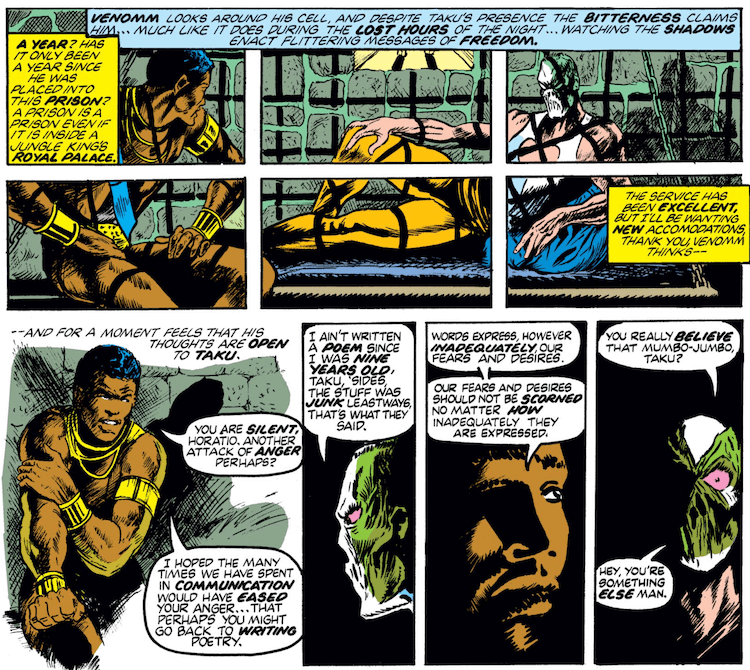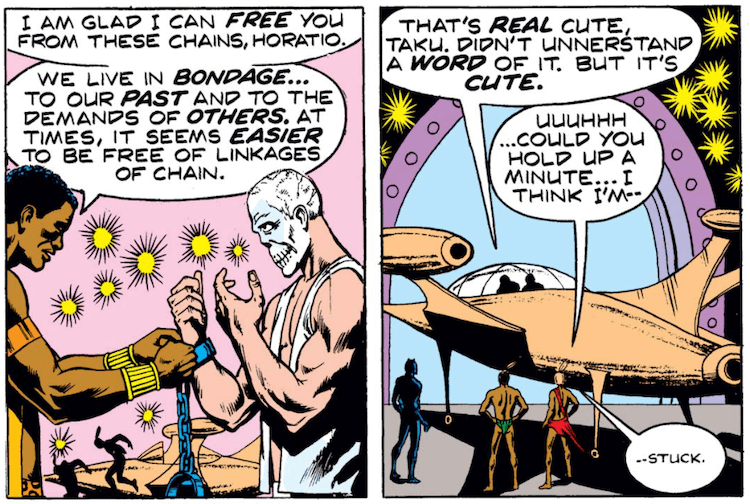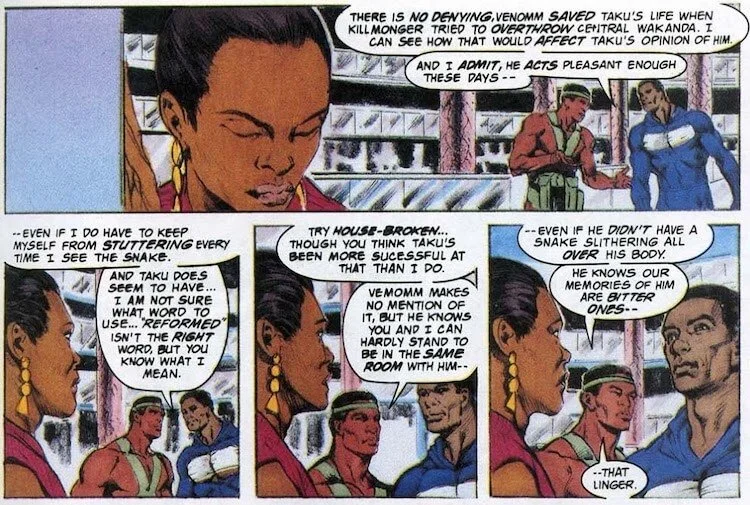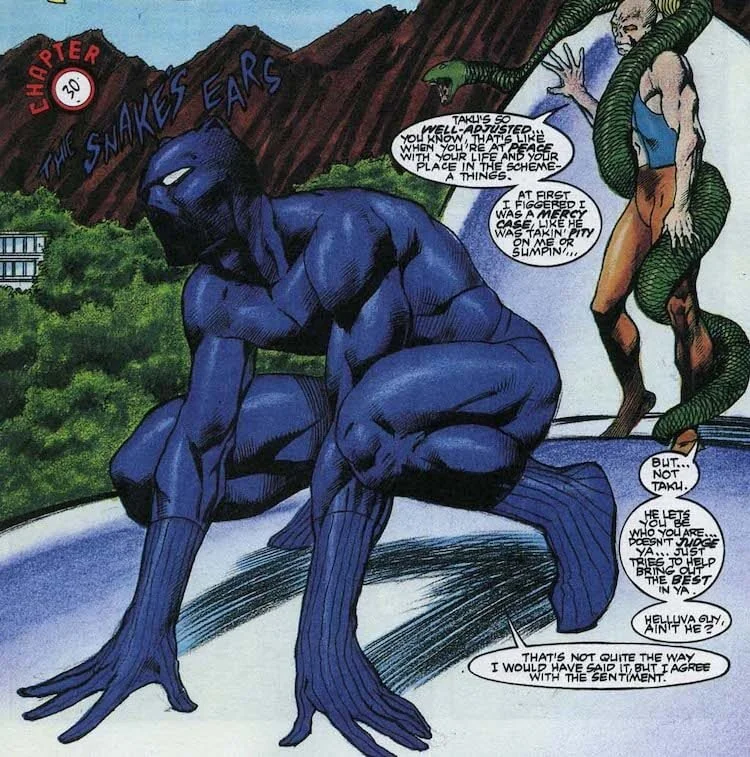Queer Superhero History: Taku and Venomm, Wakandan Husbands Forever
It’s time for another installment of Queer Superhero History, where we look back at queer characters in mainstream superhero comics, in (roughly) chronological order, to see how the landscape of LGBTQ+ rep in the genre has changed over time.
Up to now, we’ve been looking at the “official” timeline: characters who were explicitly acknowledged as queer by their publisher during the time period we’re discussing, the late 80s to the early 90s. For the next five installments, I want to go back and look at earlier, “unofficial” queer characters. These characters were heavily coded as queer by their creators, sometimes so unsubtly that there’s basically no daylight between them and “explicitly” queer characters, except for that technicality of being unacknowledged or even censored by their publisher. Last week we saw the transition from obvious subtext to explicit text for Northstar; for some of these other characters, that transition took decades.
First up: Taku and Venomm!
Who?
Okay, unless you’re a Black Panther superfan—or a collector of obscure queer-coded superhero-adjacent characters (ahem)—you have probably never heard of these two. They’ve only appeared together in about a dozen issues, scattered over half a century. So why do they merit their own post? Because while there are plenty of characters who spent years or even decades exuding homoerotic subtext from within the confines of the Comics Code, in Taku and Venomm’s case, we know for a fact that that subtext was intentional—even as far back as 1974.
Check out Taku employing the Power Stance of Subtextual Romantic Intentions in the first panel. [Jungle Action #8 (January 1974), art by Rich Buckler and Klaus Janson.]
Taku is an advisor to King T’Challa of Wakanda, a.k.a. Black Panther. Introduced in Avengers #68 (July 1969) and created by Roy Thomas and John Buscema, Taku is a gentle, poetic soul who tends to advocate for peace.
Venomm (not to be confused with the much better known Marvel character Venom), on the other hand, was originally a supervillain. He was introduced in the cringily-named Jungle Action #6 (September 1973), and was created by Don McGregor and Rich Buckler. As a child, young Horatio Walters was an outcast, and became more of one when a classmate threw acid in his face, leaving him horribly disfigured. Horatio developed a kinship with snakes, allowing them to bite him until he became immune to their venom (note to readers: don’t do this) and training them to help him commit crimes.
The newly minted villain Venomm is recruited by Erik Killmonger to try to take over Wakanda. He is defeated by Black Panther and imprisoned in the palace. There he meets Taku, who treats him with kindness, calling him “Horatio” instead of “Venomm” and checking on his snakes for him. (Aw!) A year passes, and the two grow closer, with Taku encouraging Venomm to write poetry to express his “fears and desires.” Venomm admits that Taku “treated [him] right,” but that he “feel[s] like a kept woman.”
“Draw me like one of your French girls, Taku.” [Jungle Action #14 (March 1975), art by Billy Graham (not that one) and Pablo Marcos.]
Despite their friendship, Venomm stages a violent escape. “I ain’t some lost cause for you ta work on,” he says when Taku tries to talk him down. “You were never a cause to me, Horatio Walters. I thought you understood that,” Taku replies. Ultimately, Venomm can’t bring himself to kill Taku—and when one of Killmonger’s other minions attempts to do so, Venomm saves Taku’s life and defects permanently to Team Black Panther.
The dialogue and even the body language between Taku and Venomm are highly suggestive (I cannot get over that “kept woman” line), but not necessarily conclusive. Superhero comics are literally full of half-naked men melodramatically saving each other, and most of the time it’s just supposed to be, like, the intense bonds of heterosexual brothers-in-arms or whatever. But Taku and Venomm’s homoerotic subtext was entirely intentional, and we owe it all to Don McGregor.
I just think this is sweet. (Don’t worry about the guy stuck to the plane in the second panel.) [Jungle Action #18 (November 1975), art by Billy Graham and Bob McLeod.]
Don McGregor (who is white and, as far as I know, straight) has a long history of advocating for diversity in comics. When he started working at Marvel in the early 70s, he pointed out that Jungle Action was full of, well, racist stories featuring “white men and women saving Africans or being threatened by them,” and suggested that the book should star an African hero instead. Marvel made Black Panther the headliner and assigned McGregor to write it; he turned in a run that is still acclaimed today.
He has said in many interviews that he always intended for Taku and Venomm to be gay. However, earlier that year he’d had to wage an elaborate campaign to get the first (straight) interracial kiss in mainstream color comics published, in the Marvel book Killraven. (McGregor was also responsible for the first interracial kiss in mainstream black and white comics published, but that was an accident. It has nothing to do with Taku and Venomm but you should read the story anyway because it’s very funny.)
“Taku and Venomm were the first characters I ever did that were intended to be gay. But after the complications of doing an interracial kiss in Killraven came about, I knew that would be my last book if I tried it. And it would never have seen print,” McGregor told Marvel.com in 2020. Plus, of course, the Comics Code still forbade queer content in 1975. So McGregor had to keep their relationship coded—but if you know what you’re looking for, the coding is very clear.
McGregor returned to the characters in the 1991 miniseries Black Panther: Panther’s Prey. Sixteen years later, the state of queer representation in comics was very different: the Comics Code had been updated to permit queer characters, and DC had several who were out. But Marvel was still lagging behind—Northstar wouldn’t come out until the following year.
This is not how anyone describes two guys who just hang out together a lot, with or without a snake. [Black Panther: Panther’s Prey #2 (June 1991), art by Dwayne Turner.]
So McGregor used coding again, but this time, the plausible deniability is paper thin. In issue #2, T’Challa tells another advisor, W’Kabi, that “I fear Taku has used poor judgment in choosing Venomm as a companion. As his friend, I worry about him.” Lest you think this is a platonic use of the word “companion,” W’Kabi replies: “I wish somebody’d worried about me before I married Chandra. Not that I would have listened, you understand.” It’s not a throwaway line, either, but smack dab in the middle of a full three pages of T’Challa and W’Kabi dishing about Taku and Venomm’s relationship. (W’Kabi also describes Venomm as having been “house-broken” by Taku. Wow.)
In issue #4, T’Challa and Venomm have a heart to heart. “I guess it’s lucky for you Taku doesn’t mind snakes,” T’Challa says. This gives Venomm the opportunity to gush about how accepting and understanding Taku is, a speech that he tells Taku “would-a made you blush you’d-a heard it.” Later, peaceful Taku immediately throws hands when W’kabi accuses Venomm of being a spy. (He is not; unbeknownst to Venomm, the real spy planted a bug in his pet snake Matilda. Naturally.) I’m sure there were still some readers who didn’t catch the exact nature of Taku and Venomm’s…companionship…but plenty did.
Venomm gushes accurately about Taku. And no, I can’t explain his vest and dance tights combo. [Black Panther: Panther’s Prey #4 (October 1991), art by Dwayne Turner.]
Though Taku made sporadic appearances after this, Venomm disappeared from comics until Marvel’s 2022 Pride anthology. In a five page story by Danny Lore and Lucas Werneck, Taku and Venomm—now confirmed to be happily married—beat up some unsavory invaders in the Wakandan jungle, then share a romantic, snake-infested picnic. “You are the man I love. You have always been the man I was destined to love,” Taku tells Venomm before the two men share a kiss. (Interestingly, the story also implies that Venomm had unrequited feelings for Killmonger before he met Taku.)
Are Taku and Venomm ever going to be marquee characters? Probably not. Taku didn’t even make it into the movies when his frenemy W’Kabi did, and it’s hard to become a star when your name is exactly the same as a much more famous character’s, but misspelled.
You guys, I’m verklempt. [Marvel’s Voices: Pride 2022 (August 2022), art by Lucas Werneck. And don’t worry, it came out in June—comics are often dated two months in advance of their actual publication.]
But I love that McGregor did his damnedest to make the Marvel universe more inclusive a full half century ago. I love that he kept moving the envelope whenever he could, and spoke openly about his intentions as soon as it wouldn’t ruin his career to do so. I love that someone at Marvel dug these characters out of obscurity three years ago and made sure we all knew that they got their happy ending. I love Matilda the snake.
Taku and Venomm may seem like a laughably obscure piece of trivia today, but 50 years ago, they were a major risk for McGregor, and a major step forward for comics, and that’s worth remembering—silly misspelled name and all.





